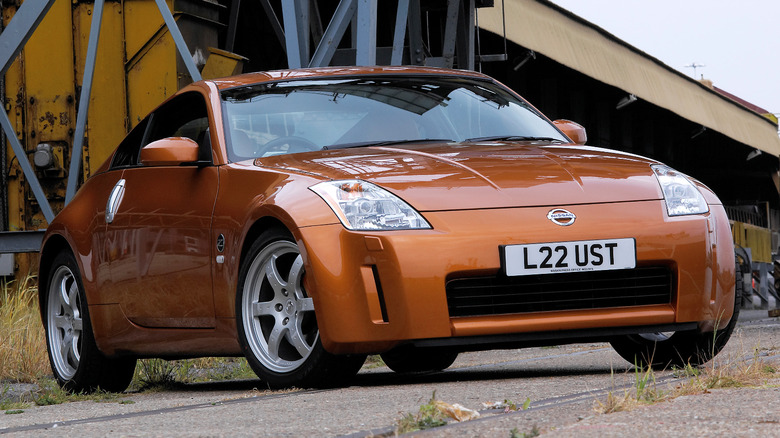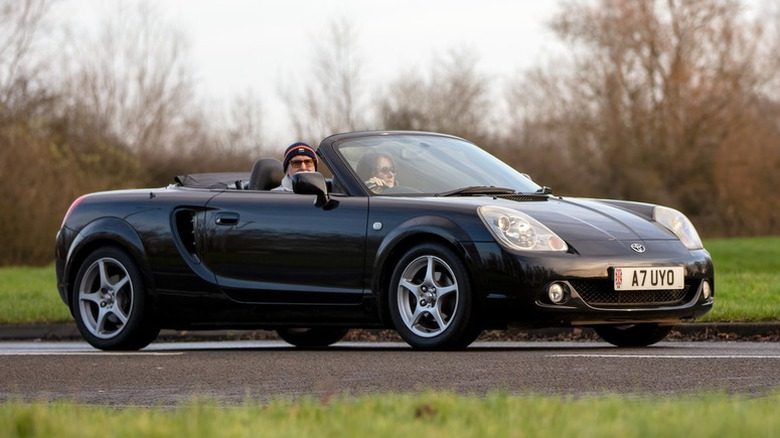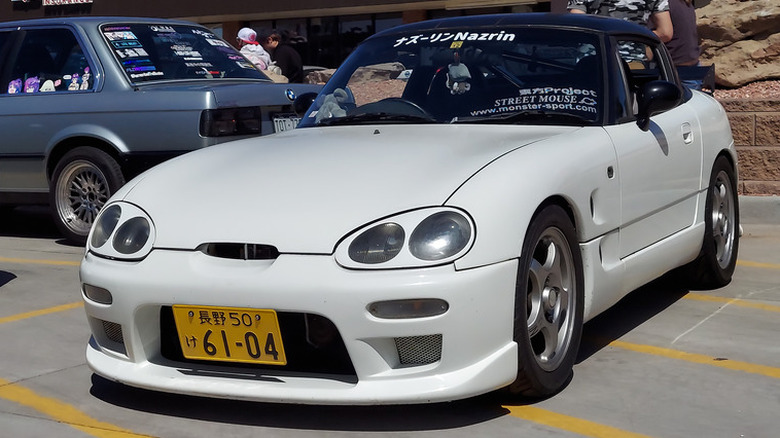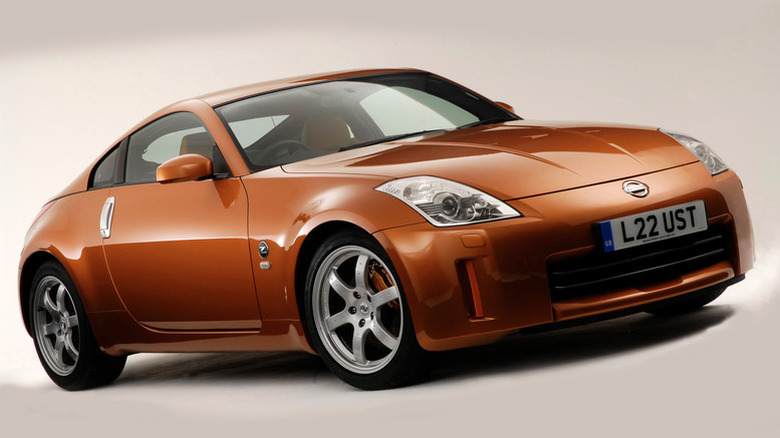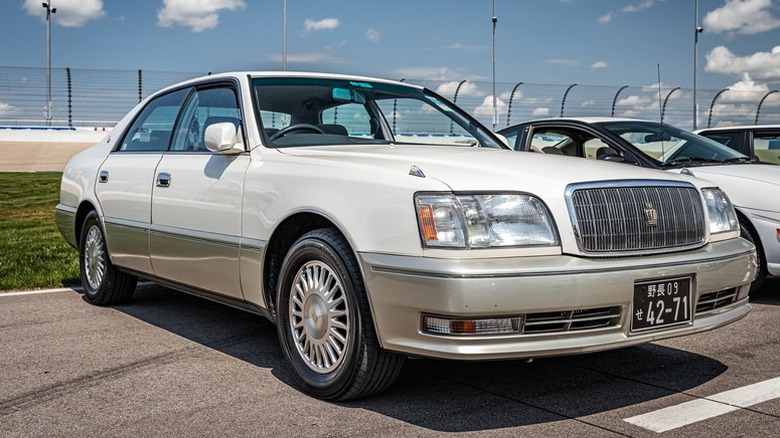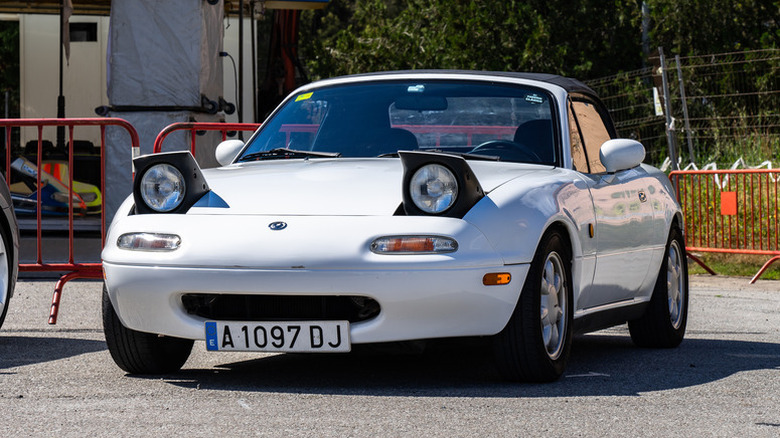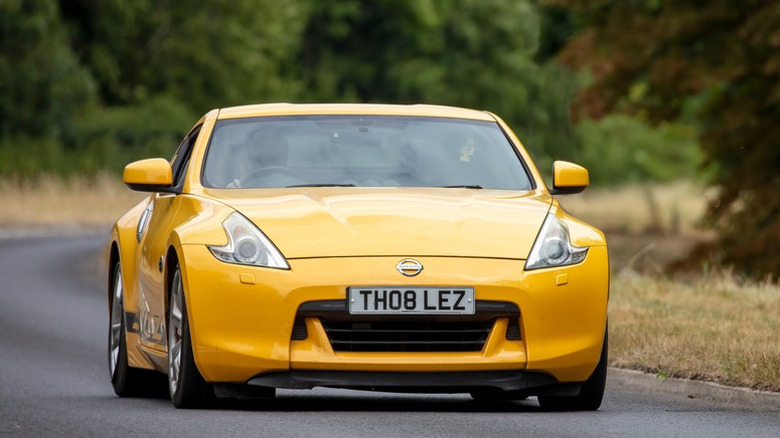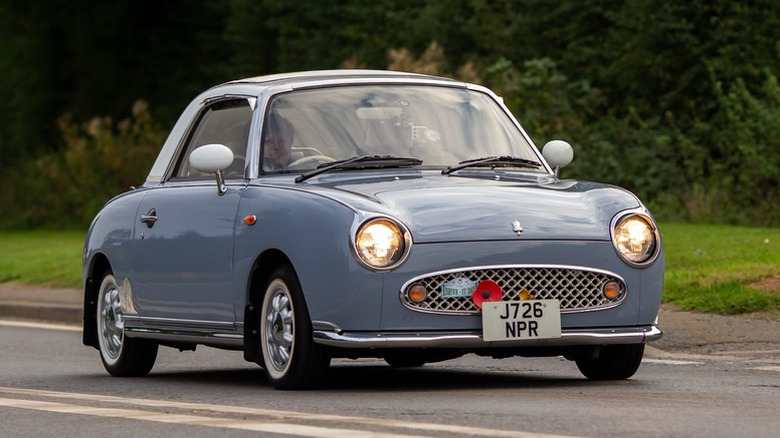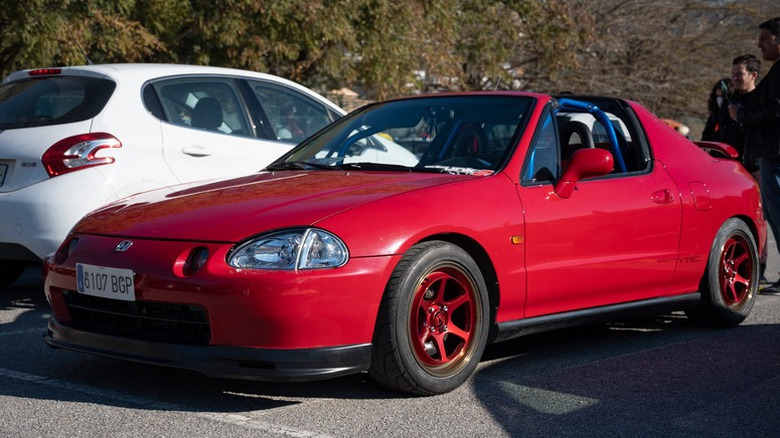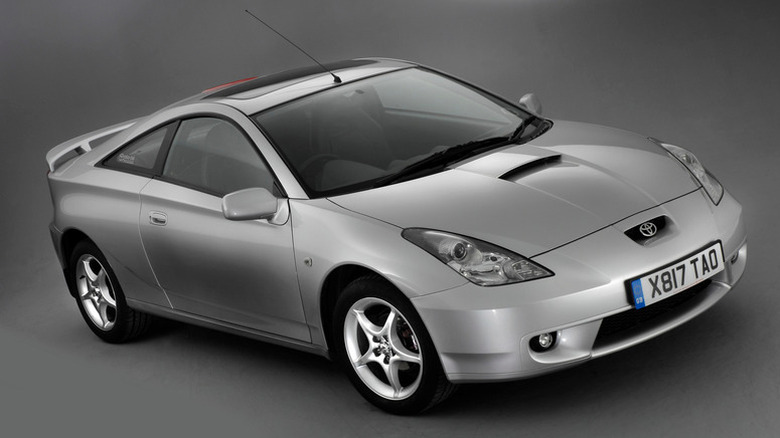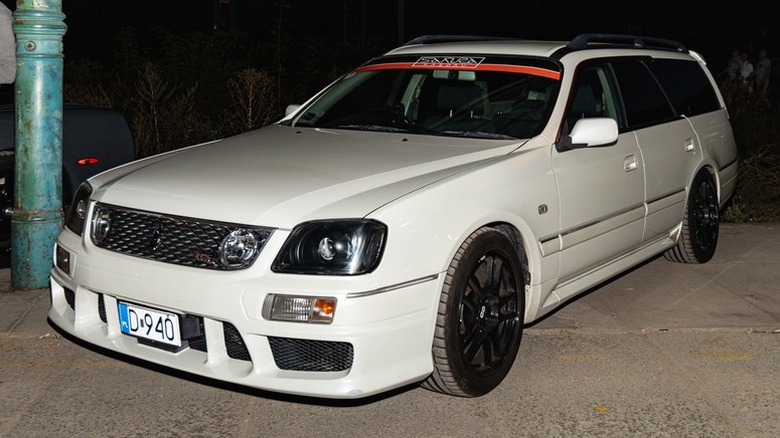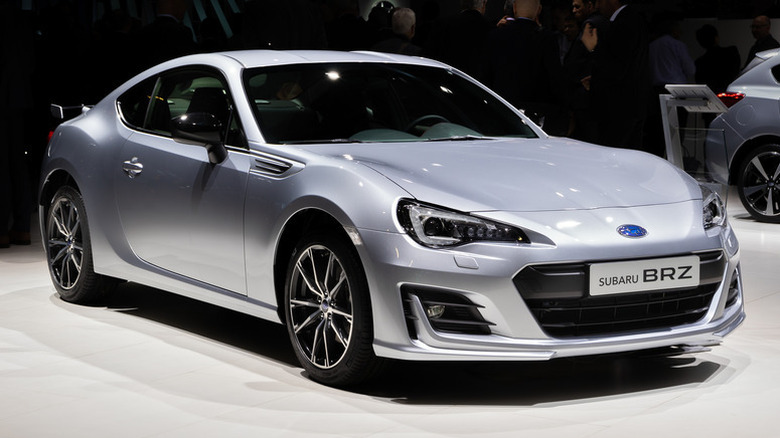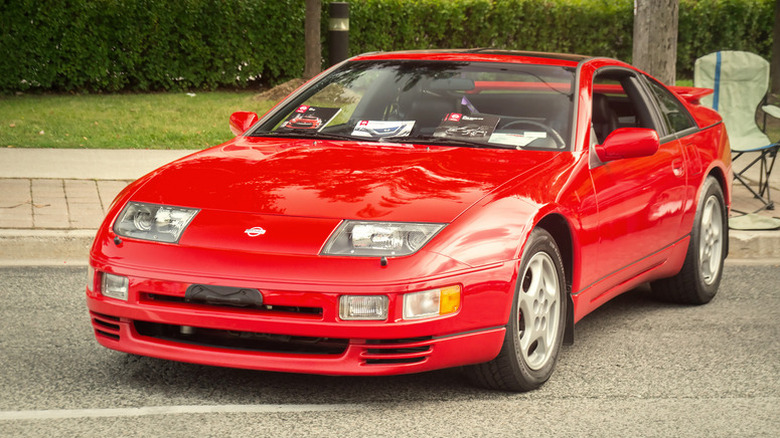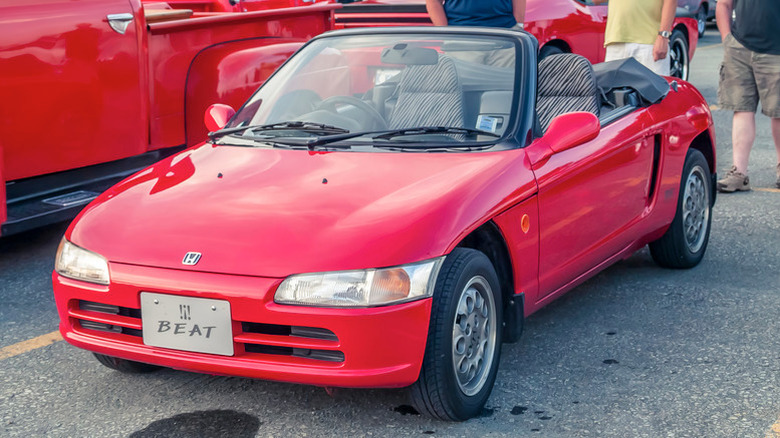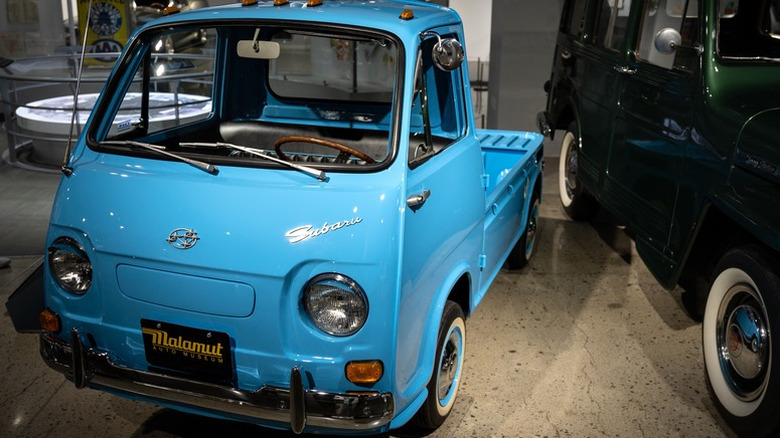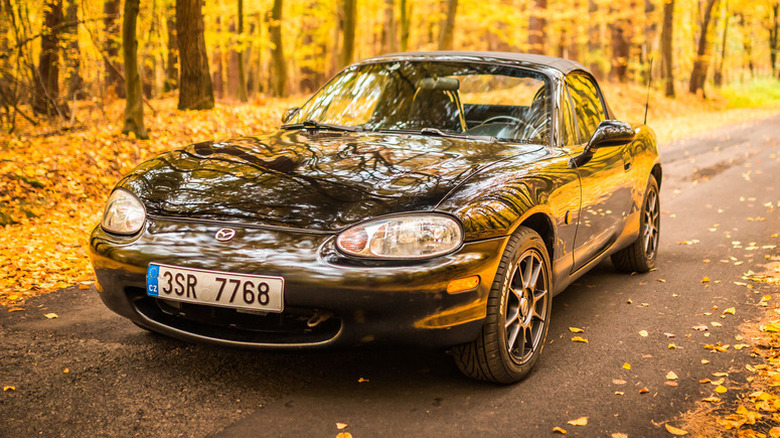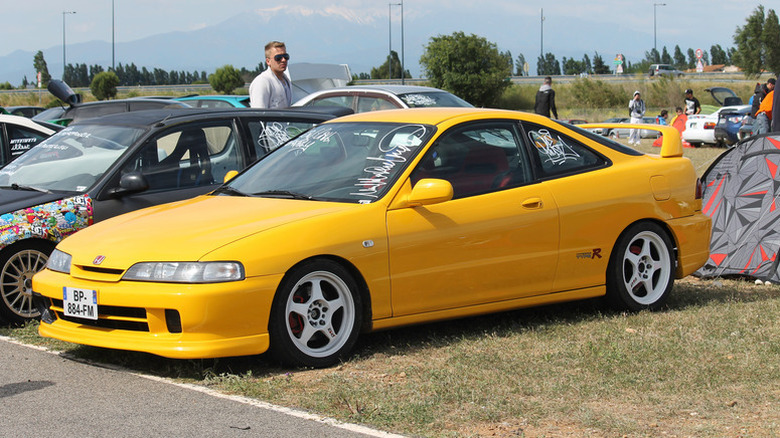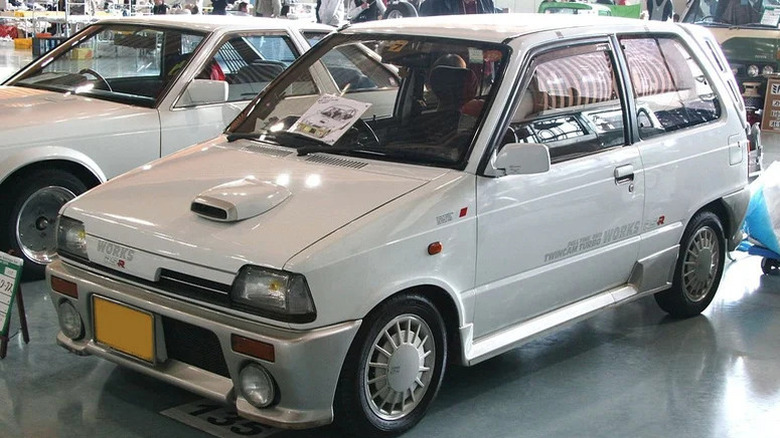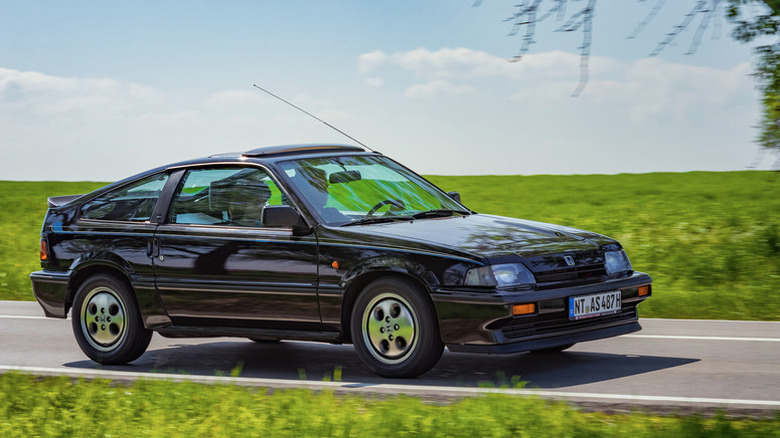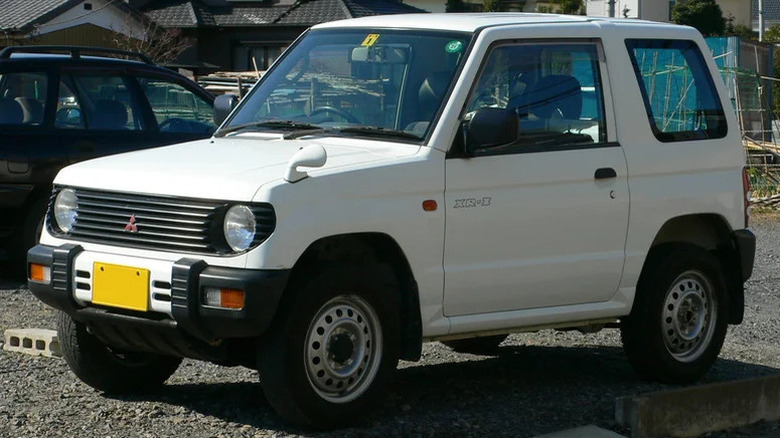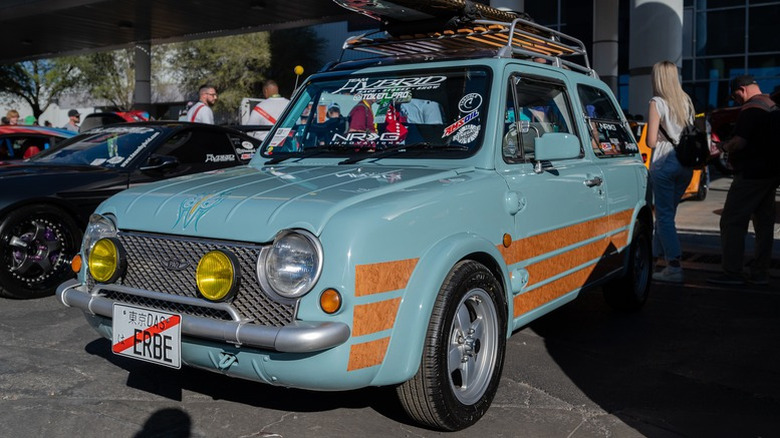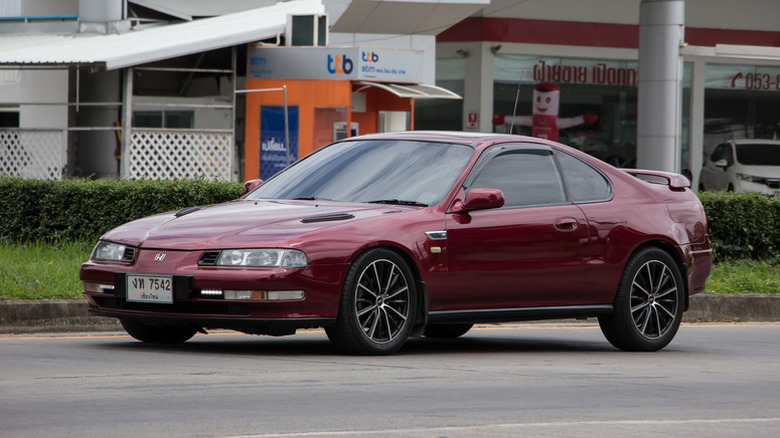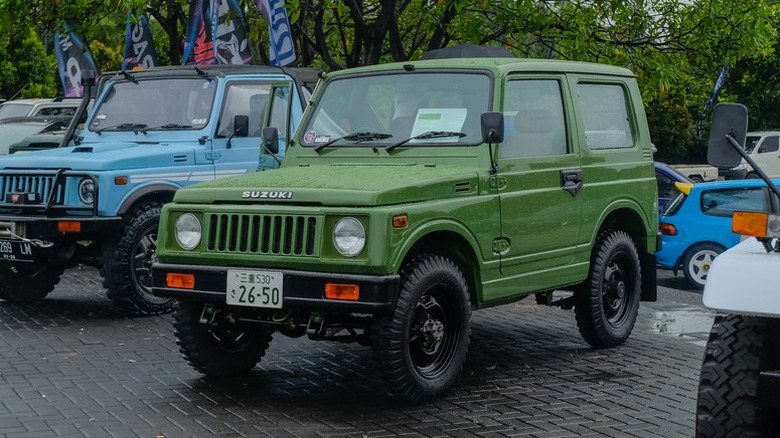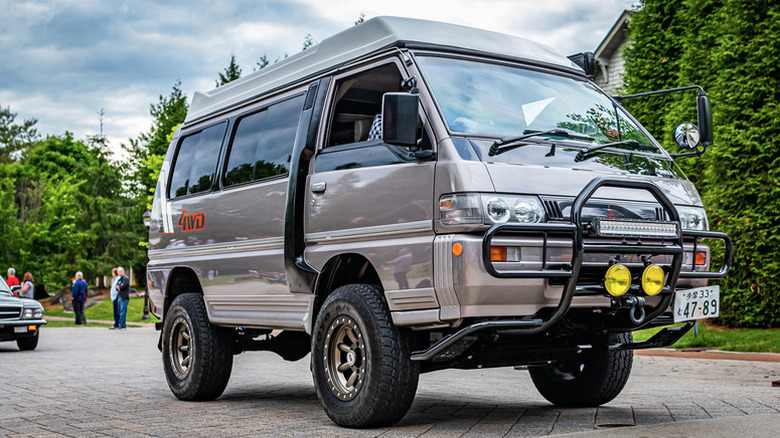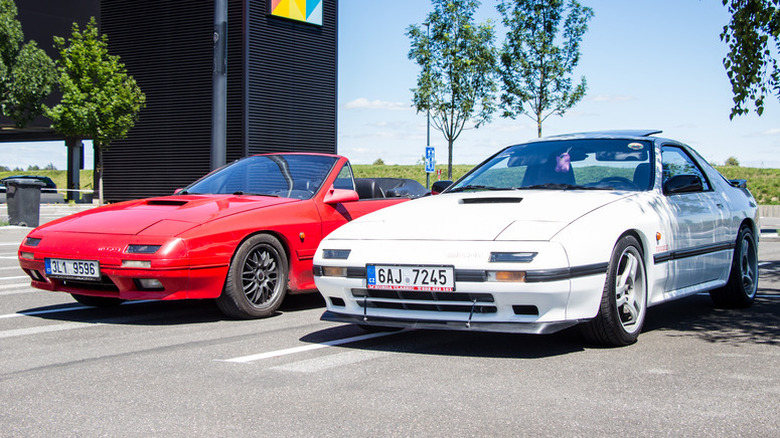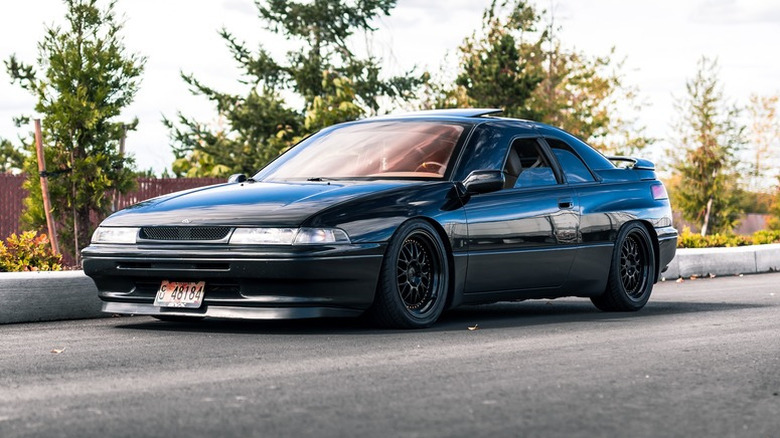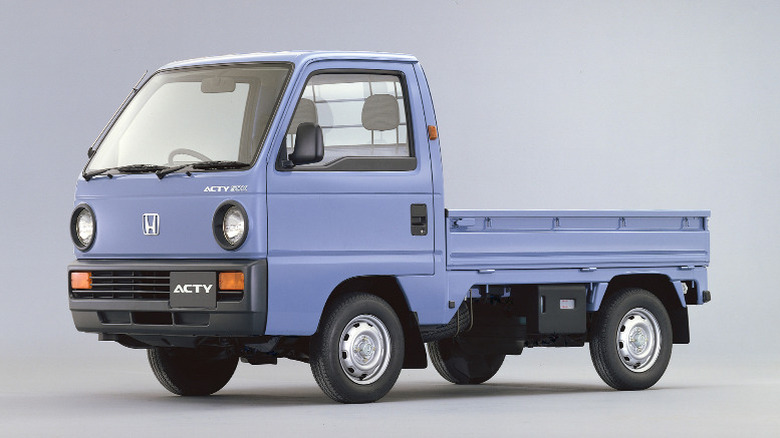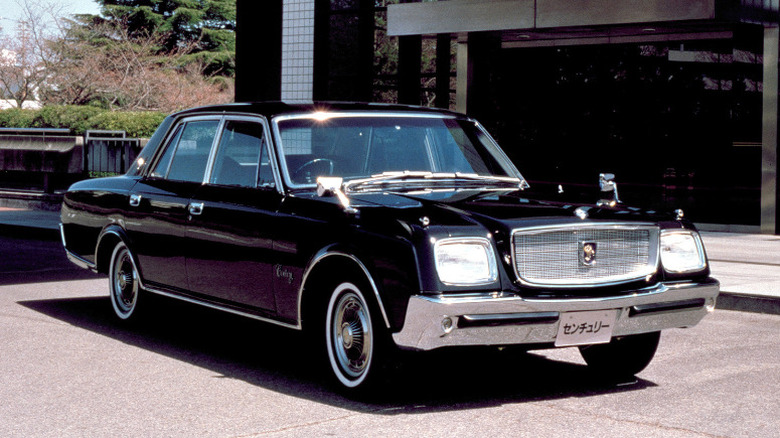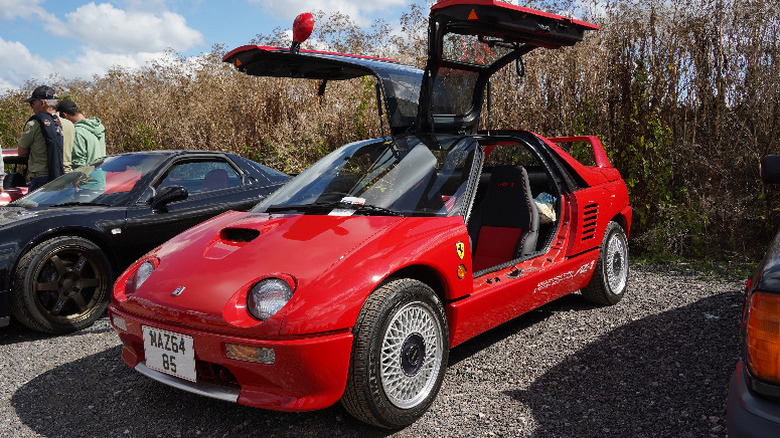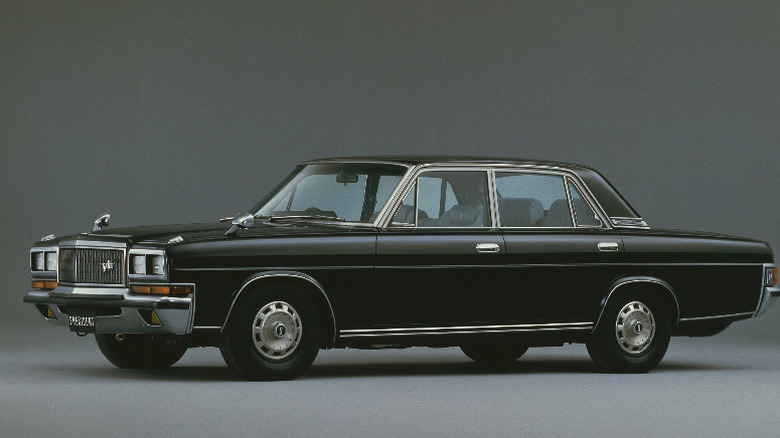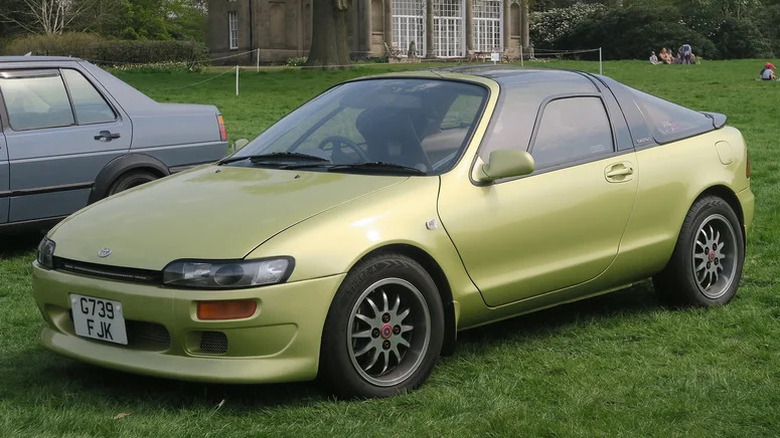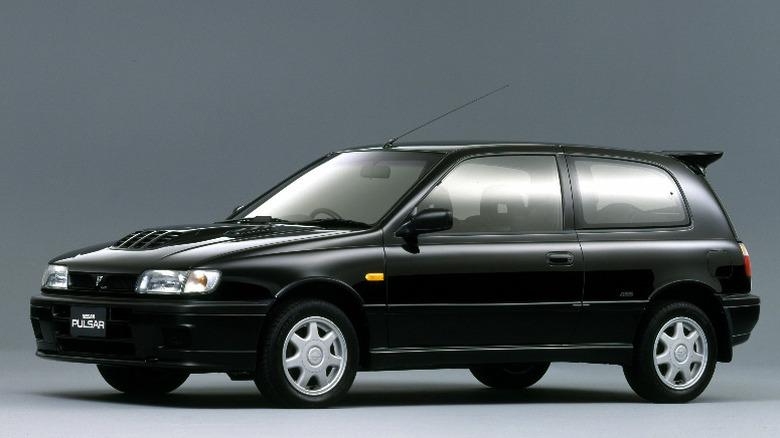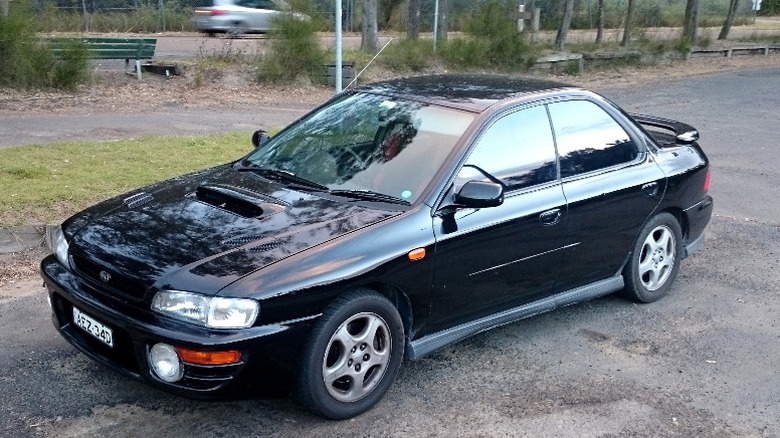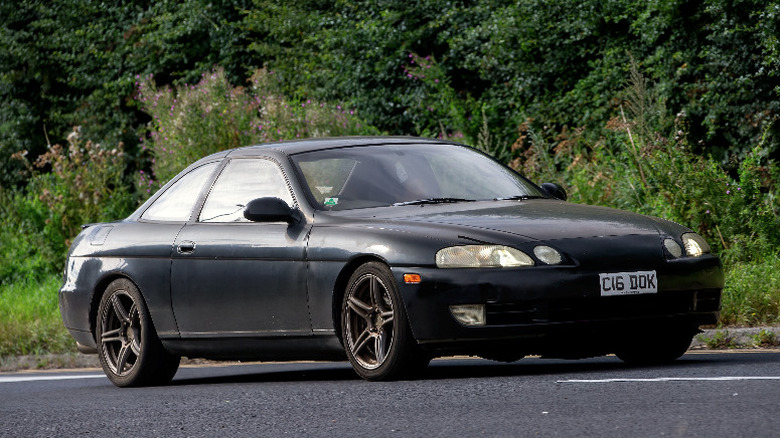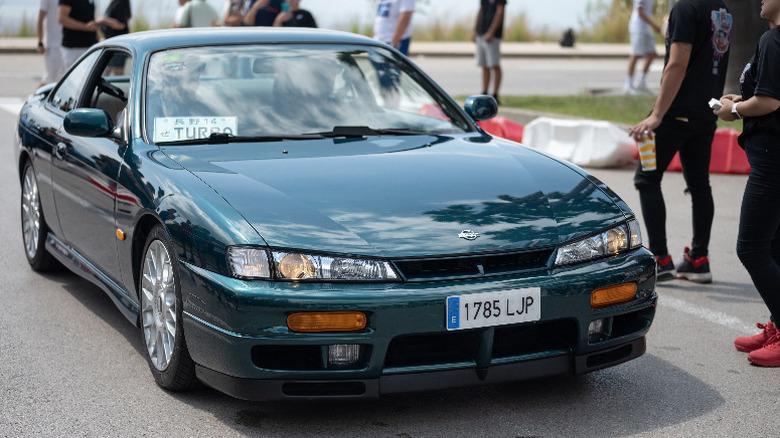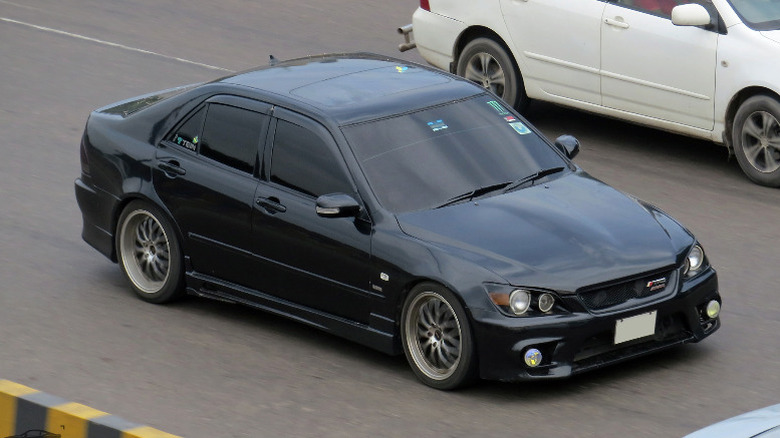35 Affordable JDM Cars That We Recommend
As more cars from Japan's golden era are becoming eligible to import Stateside under the 25-year rule, average values for the segment are on a one-way trend upward. JDM, or Japanese Domestic Market, cars are among the hottest trends in the current car market, with the most in-demand models shooting up double-digit percentages in value every year (via Hagerty). It might seem next to impossible for cash-strapped enthusiasts to get their hands on a tasteful JDM classic, but even with the market rising, there are still plenty of affordable models out there for every kind of collector.
Look past the usual raft of Supras and Skylines, and Japan's biggest manufacturers have a wealth of cool lesser-known, or lesser-appreciated vehicles in their back catalogs. Whether you're looking for a low-mileage garage queen or a low-cost project, there are plenty of options out there for less than $20,000, and a few for less than half of that. Granted, the rarity of a few of these cars means they'll require a little more effort than average to actually buy, but if you can find one, they're all well worth the money.Average sale prices clock in at around $17,000, but $10,000 should be enough for a cheaper, higher mileage example.
Toyota MR2
There are very few, if any, mid-engined cars on the market that are cheaper than the Toyota MR2. The third generation of the roadster boasts sharp steering, a comfortable cabin, and a peppy engine, says Parkers, and since it packs a frugal 1.8L engine, it won't cost much in fuel either. It's also built with Toyota's signature high build quality, and it ranked second place in our list of the most reliable convertibles on the market.
That mid-engine layout gives the car a naturally better handling profile than many other cars of its age, and it's backed up by a light curb weight that, combined with the low driving position, makes the car feel significantly faster to drive than it is. Much like a Mazda Miata, the MR2 offers a cheap and accessible way for drivers to enjoy themselves without worrying about getting to speeds that will lose their license, although it's worth keeping in mind that this is strictly a weekend toy only. The car's midship layout means that luggage space is practically non-existent, so it's quite impractical to daily drive even by sports car standards.Examples of the car vary in price based on mileage and condition, with average prices hovering around $14,000.
Suzuki Cappuccino
Kei cars are a unique segment that has remained popular in Japan for decades thanks to reduced tax and running costs over a standard-size vehicles. They're small, lightweight, and feature engines of no more than 660cc in capacity (via MotorTrend). Most Kei cars are what you could call 'functional' rather than interesting, and offer little value to foreign collectors other than being novelties. However, Kei sports cars are a different matter altogether, and the Suzuki Cappuccino is one of the best examples of these miniature performance cars. The Cappuccino was built as a rival to the Honda Beat and Daihatsu Copen, and it was produced between 1991 and 1997, according to Auto Express.
With a classic front-engine, rear-driven layout and a feather-light curb weight of less than 1,600 lbs, driving a Cappuccino is like having your own street-legal go-kart. It's so small that Auto Express reports you can choose your own line within your lane on the road, something that's all but impossible in larger, more modern cars. Its relative lack of power and tiny size means that it won't be pleasant to drive on the highway, and taller or larger drivers might struggle to fit comfortably within the tight cabin. However, as far as quirky JDM cars go, there are few things that beat a Cappuccino. The car was never officially sold in the States but a few examples have made their way over anyway, and it can just about be found for less than $15,000 on the rare occasions that they appear for sale.
Nissan 350Z
The 350Z, or Fairlady Z as it was called in Japan, was unveiled at a time of great uncertainty for Nissan. The collapse of the Japanese economy had pushed the company to the brink of bankruptcy, and it had entered into a partnership with French automaker Renault in a bid to stay solvent (via Britannica). The 350Z was designed to take the Z line of sports cars back to basics, abandoning the tech-heavy, high-priced approach that had seen the 300ZX axed without an immediate successor (via MotorTrend). Instead, the 350Z focused on the basics: a tried-and-tested 3.5L V6 engine, excellent handling, and a low asking price.
A review from Car and Driver at the time of the car's release points out how much better value the 350Z was than its rivals: it was only a few thousand dollars more than a Toyota MR2, yet it boasted around double the horsepower. In fact, it was only a few horses shy of the base-spec Porsche 911 of the era, which cost over twice as much as the 350Z. Suffice it to say, the relaunched Z car was a big sales success, and it's this popularity that's helped keep resale prices reasonable today. As a bonus, all those shared parts used on the car make it one of the most reliable sports cars on the market, so maintenance costs shouldn't be an issue either.
Toyota Crown
In 2022, Toyota announced it was launching the Crown back into the U.S. market as a weirdly-styled hybrid after more than 50 years away from the United States market, but throughout that time it's remained a firm favorite at home in Japan. First-to-fourth generation Crowns were officially imported to America until 1971, but the Japanese-market car is now in its fifteenth generation, so there are plenty of variants for enthusiasts to pick from (via Japanese Nostalgic Car). Their success is partly due to the fact that they've never deviated much from their original formula: big, plush executive cars with rear-wheel drive and (usually) plenty of poke under the hood.
Crowns from the '80s and '90s are rare to find for sale in the U.S., but a handful can be found for sale through specialist importers. Prices vary depending upon their condition, but the average example can be bought for just under $10,000. If a Crown still isn't fancy enough, the flagship Toyota Century limousine can also be found from the same dealer within budget, although its V12 engine and complex construction mean that maintenance will likely be considerably more expensive.
Mazda MX-5 Miata (NA)
It would be criminal to publish a list of great affordable Japanese cars without mentioning one of the best-selling sports cars of all, the Mazda Miata. While buying one of these won't win any prizes for originality, there's a good reason why the little roadsters have remained endearingly popular for decades now. They combine all the best values of a good cheap sports car into one: light curb weight, a low asking price, and handling that'll always put a smile on your face. We've ranked the NA Miata as one of the best Mazdas ever made, and it's made even better by the fact that it can be picked up so cheaply.
It's not quite as easy to find an old Miata in good condition as it once was – they do suffer from rust, and plenty have been lost to accidents or poor-quality modifications over the years. However, a quick glance down any popular auction site will prove that there are still plenty of examples available for $10,000 or so, with even lower-mileage examples still being available within the $20,000 budget.
Nissan 370Z
The Nissan 370Z first went on sale for the 2009 model year, boasting a 26 horsepower boost and lighter curb weight than its predecessor, the 350Z (via NBC). It stayed in production mostly unchanged until 2020 when it was retired in preparation for the 2023 Z. By the time it reached the end of its life, most reviewers agreed that the car was past its best, and couldn't keep up with its modern competition either on the track or on the backroads.
Its unusually long production run has had one big benefit though: as there was essentially unlimited supply available for the car until 2020, demand has been comparatively low, and that's helped drive resale prices down. It's now one of the best-value used sports cars on the market, with prices for many higher-mileage or modified examples starting under the $20,000 budget and a few available for significantly less. Buyers who want a ten-or-so-year-old sports car with over 300 horses and old-school, analog handling will be hard-pressed to find anything better, at least from any Japanese manufacturer.
Nissan Figaro
Perhaps one of the weirdest JDM exports of the 1990s is the Nissan Figaro, which at first glance might look several decades older than it is. One of the last creations of Nissan's Pike Factory division, the Figaro was built as a retro-modern oddity that took design inspiration from the 1935 Datsun Roadster but featured all the latest technology inside (via Autocar). Previous Pike Factory cars had proved immensely popular in Japan, and Nissan capitalized on this by building 20,000 examples of the Figaro, all of which quickly sold.
Autocar reports that although they were never officially sold outside Japan, Figaros became very popular in Britain, and over 6,000 examples ended up being imported out of the original 20,000. Thanks to the 25-year import rule, they couldn't be imported into America until a few years ago, but now a few of them have made their way over and can be found for an average of $19,000. They're not very practical and they're certainly not very fast, but there are few cars that will draw quite as much attention as a Figaro in its price bracket.
Honda Del Sol
The Civic-based Honda Del Sol was billed as a direct successor to the revered CR-X, and although it lost a little of the lightweight magic that made the latter car so special, it's still a great affordable sports car in its own right. With its unique targa roof and inline-four engine plucked straight from the Civic range, the Del Sol was both cheap to run, but unique enough that it stood out from its rivals like the Nissan NX 2000 and Mazda MX-3.
The Del Sol was more suited to the city than much of its competition, with anti-theft devices and lights to remind drivers of open windows, reports the New York Times. It was also at home as a commuter car, with a comfortable interior and some of the most generous storage space in its segment. It wasn't the fastest or most thrilling to drive, with one review describing it as being for people who might find the Mazda Miata "a bit too hairy-chested." Nonetheless, it picked up a niche fanbase, and thanks to its Civic underpinnings, there's a big aftermarket out there for any drivers who want to put a few more horses under the hood.
Buying one won't cost much either, with average resale prices reaching just under $11,000.
Toyota Celica
If spending five figures on your new Japanese sports car is out of the question altogether, the Toyota Celica offers one of the cheapest ways to get your hands on a vehicle from the Land of the Rising Sun. The seventh-generation Celica (the last one before the nameplate was axed) can be found for around $13,000 on average, although less clean examples are readily available under $10,000. It covers all the main bases for an affordable sports car: it's fun to drive, economical to run, and boasts suitably lively handling when you put your foot down, reports Whatcar.
It's also arguably one of the best-looking cheap sports cars of its era, with a unique silhouette that's less cutesy than the similarly-priced Mazda Miata or Audi TT of the same era. Like many small sports cars, the Celica isn't very practical as a daily driver, as the small rear seats can at most hold a few bags of groceries or a small child. As well as boasting a low asking price, the Celica also benefits from Toyota's famed reliability, with reports suggesting you can expect 250,000-300,000 miles out of a well-maintained example.
Nissan Stagea
Skylines are still some of the most iconic JDM cars of all, but the premiums that the nameplate now commands can make it almost impossible to find a reasonably priced example in good condition. One way around this is to instead buy a Nissan Stagea, a Japan-only wagon that shares many of its internals with the Skyline, but can be found without the huge markups. The car was first introduced in Japan in 1996, so multiple model years can now be imported under the 25-year rule. Even so, the Stagea remains a real rarity in America.
Those that have been registered stateside can't always be bought within a $20,000 budget, but prices vary a lot and multiple examples have sold on auction sites for $10,000 or less. While it might look closer in styling to the R34 Skyline, the first-gen Stagea is actually based on the R33, and both cars shared the same engine options (via JDM4All). That means there's a choice of RB20, RB25, and RB25DET engines, making 130, 190, and 235 horsepower, respectively. Although of course, anyone familiar with the tuning capabilities of the Skyline will know how easily those figures can be increased.
Subaru BRZ
The BRZ might be one of the newest cars on this list, but it's just as affordable. Clean examples can be found for just under $20,000, and for that, you get a car that's around ten years old and still looks modern thanks to the first-generation car's long production run. In fact, the second generation car only debuted in 2022, and it's arguably even better than its predecessor, but it costs more than $20,000 so it's not eligible for this list.
The original BRZ is still an excellent sports car, with engaging handling and a comfortable enough cabin that it's easy to use as a daily driver. Some drivers might find it a little lacking in the power department, but that's something that can be fairly easily and cheaply solved through aftermarket parts. Even when it's bone stock though, the BRZ is arguably one of the best affordable sports cars on the market right now, and a great entry point into Japanese sports car ownership.
Nissan 300ZX (Z32)
The Z32 Nissan 300ZX is still arguably one of the best Z-cars of all, sporting cutting-edge design and flagship-worthy performance. From its smooth, sleek looks to its innovative HICAS four-wheel steering system, the 300ZX took several big leaps forward both for Nissan as a manufacturer and for Japanese sports car design in general. Suddenly, the boxy proportions and pop-up lights of '80s JDM cars looked very old-school, not to mention the fact that the new Z car could leave all of them in the rearview mirror on the track.
However, the Z32's high asking price limited its sales success in America and meant that it was discontinued in 1996 without a direct successor (via CarSalesBase). It might not be as easy to find on the used market as some of its JDM contemporaries, but the 300ZX Z32 is still relatively affordable to buy today. Examples vary considerably in price based on mileage and condition, but Classic data shows resale prices averaging around $13,000. The very cheapest examples can be found for $10,000 or less, and JDM cars, which are right-hand drive, can often be found cheaper than their American-market, left-hand drive counterparts.
Honda Beat
A change in Japanese kei car regulations in 1990 saw larger engines and slightly larger bodies allowed than before, and manufacturers scrambled to take advantage of the relaxed rules. This led to a new wave of faster, sportier kei cars, and one of the most successful of those was the Honda Beat. Over 33,000 examples of the car were built over a five-year production period, all of which were originally sold in Japan. However, in the years since then, the pint-sized Beat has gained a cult following in various other countries around the world, including in the U.S.
It might only boast 63 horsepower from its 660cc engine, but the Beat feels faster to drive than it is thanks to its light curb weight. Its small size makes it almost guaranteed to attract attention wherever it goes, and it's affordable to boot. Even the cleanest, lowest mileage examples shouldn't cost much more than $20,000, and average prices sit far lower, around $9,000 at the time of writing.
Subaru Sambar
Another tiny classic with a cult following in America is the Subaru Sambar, which is available both as a truck and as a minivan. It was first launched in the early '60s to meet kei regulations, and as those regulations have allowed for slightly larger vehicles over the years, it has expanded accordingly. Even later models are still comically small by American standards, but nonetheless, there's seating for up to seven people in minivan variants. The exact horsepower output varies by model and year, but don't expect to get anywhere fast –- '90s examples of the Sambar only made somewhere around 45 to 55 horsepower.
The Sambar was officially discontinued in Japan in 2014, and in the years since then, a growing number of older examples have found their way to the United States thanks to their cute looks and tiny dimensions. A rising number of imported examples have popped up for sale in recent years, with many available for less than $10,000. The average sale price over the past five years sits closer to $11,000 according to Classic data.
Mazda MX-5 Miata (NB)
While the original NA Miata is still the definitive classic Miata for many people, the NB can often be picked up for even less than its predecessor. The second generation didn't bring any significant mechanical changes, with most of the big differences concerning the car's exterior styling. New lights, more sculpted bodywork, and updated wheels mean that there's no mistaking an NB for an NA from the outside, even if inside the two cars look fairly similar.
A new steering wheel and some small styling tweaks were pretty much all that was offered in terms of cabin improvements, but then focusing too much on the cabin is arguably missing the point of buying a Miata entirely. They're built to be driven, and many of the used examples on the market today will have been driven hard at some point in their lives. Much like the NA Miata, be wary of examples that have been in accidents or have questionable modifications, and watch out for hidden rust. Even if you're picky, though, it should still be very easy to find a clean example for well within budget.
Expect to pay around $13,000 for the average example, although plenty can be found for less.
Honda Integra
The Honda Integra, or Acura Integra as it was known in the U.S., has a long-standing reputation as one of the best-handling cars of its era. If you're willing to wait for the right example, it should still be possible to get a clean late-'90s Type R for less than $20,000, although prices have risen as nostalgia levels for classic JDM cars continue to increase. The good news is that once you've bought one, you can expect some of the lowest average maintenance costs of any JDM car.
It's worth noting that the average maintenance cost takes into account the lower trims of the Integra too, and those lower trims can also be bought for much less than a Type R if you're on a tighter budget. While a mid-spec Integra from the era will be great fun to drive if you have the cash, the top-spec Type R will give you the most bang for your buck. Not to mention, the Type R should be a solid investment, as it's unlikely that prices will drop much in the near future while nostalgia remains high.
Suzuki Alto Works
The mandatory small engines and boxy proportions of kei cars mean that they're never going to be what most people would call truly fast, at least not without some serious aftermarket assistance. However, some kei cars take their sporty credentials more seriously than others — few more so than the Suzuki Alto Works. Based on the popular (but slow) Alto, the Alto Works was the result of Suzuki giving the car a thorough overhaul, with a turbocharged engine and full-time all-wheel drive available as standard in top-spec models.
The first generation car was said to be the fastest kei car ever made at the time of its release, with 63 horsepower on tap a few years before the government regulations that capped horsepower came into force in 1990. It's been suggested that the Alto Works' major improvements in performance compared to other cars of the era were what prompted the Japanese government to make such a rule in the first place. Only a handful of examples of the mad little Suzuki have made it to America, so it won't be easy to find one for sale. However, when they do come up, they're surprisingly cheap: the average Alto Works sells for under $5,000.
Honda CRX
Based on the bones of the humble Honda Civic, the CRX made up for what it lacked in power with top-tier handling and a pure back-to-basics driving experience. The formula was simple but effective: the CRX featured lighter plastic paneling to reduce weight, styling inspired by Zagato, and minimal luxuries to keep its price as affordable as possible. It remains affordable today, albeit slightly less of a bargain than it was a few years ago. Like many Japanese cars of its era, the CRX isn't as cheap as it once was, with data from Classic showing an average sale price of around $11,000 for the first-generation car.
However, there's a bizarre conspiracy theory surrounding the Barbados Yellow paint option that the CRX was offered in. The story goes that workers at the factory making the yellow cars had mysterious health problems, and owners reported their cars getting into unusual wrecks or suffering mechanical issues. For what it's worth, the folks over at Car Bibles (now part of The Drive) investigated the story and found no concrete evidence to back up these claims. They also contacted Honda, who unsurprisingly had never heard of the theory before.
Mitsubishi Pajero Mini
It's pretty unusual to see a manufacturer describe its off-road 4x4 as "friendly" and "cute" in its official press release, but that's exactly how Mitsubishi sums up the image of the Pajero Mini. Then again, this is no ordinary 4x4 -– it's a far cry from the usual imposing, all-conquering stereotype, not least because it's half the size of most other all-terrain SUVs. It was designed to fit Japan's kei car regulations and is essentially a shrunk-down version of the Pajero SUV, which was known as the Montero in America.
Still, the car features all the basics of a competent off-roader. There's a two-speed transfer case and full-time all-wheel drive, but don't expect many luxuries. The fold-down rear seats give you the option to either carry four passengers or a small amount of cargo, but not both. With a grand total of 51 horsepower available from its 659cc engine, it's far from fast, but it'll keep up with traffic on the road and might even surprise a few drivers off of it. A small number of examples have made their way to North America, with average prices hovering around $6,000.
Nissan Pao
The second production car to emerge from Nissan's Pike Factory line was the Pao, which launched to buyers in 1989. It combined a modern platform with thoroughly retro styling and proved to be very successful, with over 30,000 units sold over the course of production. Its 987cc engine made around 51 horsepower, and technically, there was seating for up to five. It should go without saying that since the car was designed for Japanese passengers and not Americans, it's probably not a good idea to bring four of your friends on an interstate road trip in one of these.
Nonetheless, it makes for a very funky daily driver, and buying one certainly won't mean breaking the bank. That is, if you can find one at all -– like many other Japanese cult classics here, it will take some patience to find a clean example for sale in the U.S. However, when they do sell, they're affordable for buyers on a tighter budget, with examples commanding around $9,000 on average.
Honda Prelude
It might not have gained quite the same legacy as its competition from the likes of Toyota and Mazda, but the Honda Prelude is well worth considering if you want a retro sports coupe without breaking the bank. Any of the five Prelude generations make a solid choice, but it's the fourth generation that arguably stands out as particularly good value on the market right now. The overhauled bodywork means that it looks vastly more modern than its predecessor, and the VTEC four-cylinder engines provide plenty of grunt.
Prices for the Prelude will vary significantly based on year, variant, and condition, but there are still plenty of affordable examples out there. Average prices sit around $12,000, although the cheapest Preludes can be picked up for $6,000 or less. Like any 30-year-old car, beware of the cheapest examples. Especially with a car like this where clean Preludes are very affordable, it's smarter to buy the best condition car you can afford and hopefully save on maintenance and repair costs later down the line.
Buyers who aren't so keen on dealing with the quirks of an old car also now have the option to buy one new, as Honda has confirmed that the relaunched Prelude will be hitting American dealerships as soon as 2026.
Suzuki Jimny
The Jimny is a long-time cult favorite among off-road enthusiasts, with a history stretching back to 1970, when it was introduced as a kei-class 4x4. Since then, it's been sold in a variety of configurations with different engines available in different markets, but Japan usually gets the smallest and least powerful version. From 1998, the introduction of the third generation Jimny streamlined these versions into a more cohesive global lineup, and now the earliest examples of that generation are available to import to the United States under the 25-year import rule.
Most examples of the Jimny that are already imported are of the second generation, with average prices clocking in around $12,000 and both modified and stock examples being available. Whether you want your Jimny to be a bare-bones off-roader or a road-oriented daily driver is a matter of personal taste, but no matter what your preference, it's easy to find examples of both kinds for well within budget.
Mitsubishi Delica
The words off-road and minivan aren't often put together in the same sentence, but the Mitsubishi Delica is just that. It's a trail-ready 4x4 with room to carry the whole family, and it's built up a niche following in the U.S. over the years. While the first generation of the Delica was more of a traditional people and cargo mover, from the second generation onwards, Mitsubishi added more all-terrain features to cater to a wider crowd. The third generation, debuting in 1986, was the tipping point –- with a two-speed transfer case, four-wheel drive, and higher ground clearance, the Delica had evolved from a humble van into a bona fide off-road vehicle.
It's the third generation onwards that's the most highly sought after among Delica enthusiasts, although the van's relatively small number of American fans means that prices have remained affordable for now. Resale prices for the Delica currently average $13,000, and even the rarest variants don't tend to cost more than $20,000.
Mazda RX-7 (FC)
The second-generation RX-7 might not boast the star power of its immediate successor, but it can be found for significantly cheaper. Some would argue it's the most underrated generation, too, since it introduced a number of innovations over the first-gen car. The design was sleeker and more streamlined than before, with designers reportedly taking inspiration from Porsche's sports car lineup. The car was also the first generation to feature a turbocharged rotary engine, paving the way for the twin-turbo rotary in the FD generation.
Prices for the FC peaked in 2022, having been on a steady rise for a few years before then. The latest data shows average sale prices dipping slightly to a little under $16,000, with the very cheapest examples selling for $6,000 or less. Buyers should expect those ultra-cheap examples to need some TLC, but a budget of $10,000 or so should be enough to get an FC in good working order. A handful of rare special edition sales are responsible for pushing the average sale price past that point, with one pristine 10th Anniversary edition selling for a whopping $62,000 at auction in 2024.
Subaru SVX
Japanese manufacturers have made plenty of unusual-looking cars over the decades, but the SVX stands out as one of the weirdest mass-produced models. It was a luxurious grand tourer with Italian styling, completely unlike anything Subaru had made before. Perhaps that was why it never sold as well as Subaru had hoped -– if nothing else, it was significantly pricier than the rest of the brand's range, so it would have stood out as a bit of an oddity in the showroom.
Subaru only managed to shift around 14,000 units before the car was axed, and today they're cheap to buy used. As a bonus, the car also benefits from being one of the cheapest luxury Japanese cars to maintain, so cash-strapped enthusiasts shouldn't have to worry too much about costly repair bills. The most expensive things to fix will likely be trim and body panels since the SVX's rarity means it'll be tricky to find replacement parts if things do get damaged. As such, buying an example that's as clean as possible is strongly advised, especially since even the most pristine examples of the car can be found within budget.
Average values for the car remain under $9,000 at the time of writing, with multiple examples selling for under $5,000.
Honda Acty
Much like the Subaru Sambar, the Honda Acty is a long-running kei truck that has gained more popularity with American enthusiasts in recent years. It remains cheap to import, with stateside examples readily available for $10,000 or less, and can be bought with either a truck bed or in van form. Unfortunately for kei truck enthusiasts, some states haven't been quite so keen to accommodate the influx of Actys and Sambars that have begun appearing on American roads.
Laws frequently change, but for now the Acty is only road legal in around 20 states, and will have to be registered for off-road use elsewhere. Before buying one, it's definitely best to check the law regarding kei vehicles in your state, and ensure you can register it. Even then, most states limit kei vehicles including the Acty to a lower speed limit than other traffic, which can be as low as 25 mph. Whether or not these restrictive rules are worth the hassle is a personal choice, but if you do decide to get an Acty, you can safely assume that you'll have the smallest — and most attention-grabbing — truck in your neighborhood.
Toyota Century
The Century is unlike any other Toyota model ever built. It's been in constant production in Japan since 1967, and in that time, it has only seen three generations. The first generation ran for a full three decades until 1997, packing a 3.0L V8 under its hood and an interior designed to appease Japan's wealthiest VIPs.
It was designed to be driven by a chauffeur, and so the most luxurious seats are the rear ones. For a short time in the '90s, Toyota offered the Century for sale in select export markets, including in the U.S., but demand was so low that it quickly reversed course. Aside from that brief foray abroad, the Century has remained a JDM model for its entire production lifespan.
Given its low production volume and unique construction, maintaining a Century will be a trickier task than most other JDM cars. However, there are a few specialists in the model across the U.S., like Duncan Imports in Virginia. At the time of writing, the Christiansburg-based importer has a selection of Centurys for sale for less than $20,000, with several available for under $10,000. Average sale prices from other specialists are no less affordable either.
Autozam AZ-1
Few kei cars are quite as instantly recognizable as the Autozam AZ-1, which looks like a shrunken supercar with gullwing doors. It featured a 657cc Suzuki-sourced engine to meet kei regulations, and had an official output of 63 horsepower. Despite its looks, the AZ-1 was never as popular as its rival kei sports cars, the Suzuki Cappuccino and Honda Beat, with only around 4,400 examples built over its production run. That rarity has helped keep its resale value higher than both the Suzuki and Honda, although examples can still be found for just under $20,000 if you're willing to wait for the right listing.
Autozam itself couldn't add any extra horsepower to the car without breaking kei rules, but owners had no such restrictions. One of the more popular modifications involves replacing the stock turbocharger with an aftermarket performance unit, which alone can significantly increase the car's power output. Given the car's light weight and tiny size, it doesn't take that much power for the car to feel properly fast to drive. Like all kei cars, whether the AZ-1 is road legal in America or not varies by state, so it's best to check local laws before buying one.
Nissan President
If the Toyota Century seems a bit too mainstream, then the Nissan President might be worth considering. The few examples that have been imported to America are similarly affordable to buy, although will likely be similarly tricky to maintain. It has been offered with a choice of six-cylinder or V8 engines, although later models all feature a V8. As Nissan's top-of-the-line JDM car, the recipe has remained similar over the decades: plenty of power, plenty of interior space, and a high level of safety tech to keep occupants protected in case of an accident.
The President is still a rare car to find in the U.S., even by JDM standards, but the few imports that have appeared for sale mostly sell for $10,000 or less. The car's boxy, old-school Japanese styling makes it a great choice for project car builders who want the big-body JDM look and V8 power, and are prepared to fork out for rare parts should something go wrong.
Toyota Sera
With its high-tech in-car audio system and distinctive gullwing doors, we've previously argued that the Toyota Sera was ahead of its time. Of course, it's not like every modern car now features such outlandish doors — if nothing else because many of us still need to use multi-story parking lots on a regular basis. However, the Sera provided the inspiration for one of the most famous gullwing-doored cars, the McLaren F1. The Sera's construction process was also pioneering, with Toyota manufacturing its panels using a unique press designed to make low-volume production cheaper and easier.
Throughout a half-decade production run, the Sera's popularity with buyers varied considerably. At launch, it sold well, but its timing was unfortunate, as Japanese buyers were just starting to be hit by the burst of the country's economic bubble. Sales quickly tanked, despite Toyota updating the car multiple times in a bid to make it more appealing. Eventually, production ended with around 16,000 examples built. Today, a Sera can be bought for around $11,000 on average, although some pristine cars have sold for $17,000 or more.
Nissan Pulsar GTI-R
Subaru, Mitsubishi, and Toyota might be the three most famous Japanese brands associated with rallying, but Nissan also previously competed at the sport's top level. Its efforts in Group A produced an often overlooked homologation special, the Pulsar GTI-R. It featured a 230 horsepower SR20DET engine and the same ATTESA all-wheel drive system that famously appeared in the R32 Skyline GT-R. Appropriately, the Skyline became known as "Godzilla," while the Pulsar GTI-R was nicknamed "Baby Godzilla."
Finding an example of the Pulsar GTI-R for sale will be difficult, and finding one within budget will be even more of a challenge. Nonetheless, it can be done, particularly if you're willing to import one from Europe. One Canadian example also sold on Bring a Trailer for $17,500 in November 2024, while a non-modified example with American registration sold for $16,500 on Cars & Bids in 2022. It might be tricky to find, but there's simply no other hot hatch out there that combines the DNA of a competition rally car with the all-wheel drive grip of the R32 Skyline GT-R.
Subaru Impreza WRX (GC8)
The original generation of the Subaru Impreza WRX might not have been as fast as its immediate successors, but it's safe to say that, without it, the nameplate would never have carried as much weight with enthusiasts. The WRX was born from Subaru's desire to create a competition version of the Impreza, in order to improve its fortunes in the World Rally Championship.
To say it improved on the talents of its predecessor, the Legacy, is an understatement. The Group A WRX's winning streak is single-handedly responsible for the brand's enduring image as a rallying brand, and the production GC8 WRX is the most affordable way to drive a piece of that rallying heritage.
Like virtually all '90s JDM icons, expect to pay a significant sum for the most pristine examples of the WRX. Less clean examples can be found for significantly less, sometimes even less than $10,000. Average prices sit a little higher, around $14,000.
Toyota Soarer
Toyota didn't launch the Lexus brand in Japan until 2005, and before then, the Japanese market had its own name for several Lexus models. The LS400 was the Celsior, the RX was the Harrier, and the SC400 was the Soarer. Toyota had previously used the Soarer name for an earlier luxurious, sporty coupe, but the 1991 model offered styling that was much more modern, as well as an improved powertrain. Under its hood sat either a 1UZ-FE 4.0L V8 or a 1JZ-GTE 2.5L V6, the latter of which was closely related to the iconic 2JZ.
The similar powerplant and sleek coupe looks make the Soarer a good alternative to the MkIV Supra, and it's far cheaper to boot. Examples of the '90s Soarer vary significantly in price based on mileage, condition, and whether or not they've been modified, but the overall average sale price for the nameplate sits around $15,000 according to Classic data.
Nissan Silvia (S14)
Buying an S-chassis is no longer as cheap as it once was, as the car's popularity with drifters has made clean examples much harder to find. However, data from Classic still shows average resale values hovering around $18,000. The Silvia should need little introduction for most JDM fans, since it has made appearances in everything from the Formula D championship to The Fast and Furious. It's well known for its ability to go sideways with minimal persuasion, and as such it makes an excellent choice for an amateur drift build.
Buying the car and keeping it stock might not be the most popular option, but it shouldn't be discounted either. The Silvia scored well against its international competition in road tests from the era, with its performance on par with German coupes. Plus, as examples get harder to find in original condition, their value might well increase, as it has with other popular JDM models like the Supra.
Toyota Altezza
Alongside the likes of the Soarer and Celsior, another short-lived JDM Toyota nameplate is the Altezza. Like its stablemates, it was created because Toyota hadn't launched the Lexus brand in Japan, and needed a way to sell its vehicles domestically. The Altezza is essentially a JDM Lexus IS, but in Japan it was offered with either a 2.0L four-cylinder or 2.0L six-cylinder engine. Both the Altezza sedan and the Altezza Gita wagon would be renamed as the IS once Lexus launched domestically in 2005.
A cheap, rear-wheel drive sports sedan is always going to be an appealing choice for cash strapped JDM enthusiasts, whether they're looking for a daily driver or a drift-ready weekend toy. Prices for imported Altezzas remain affordable, with average values of around $11,000 but clean, original examples reaching closer to $20,000. Modified or high mileage examples can sell for as little as $8,000, which is roughly on par with the cheapest examples of the American-market Lexus IS.
